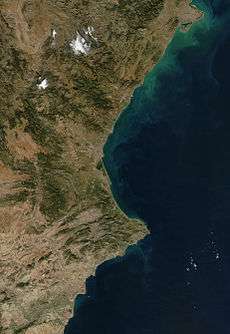Valencian Community
The Valencian Community, Valencian Country[lower-alpha 1][lower-alpha 2] or Valencia region is an autonomous community of Spain. It is the fourth most populous autonomous community after Andalusia, Catalonia and Madrid with more than five million inhabitants.[7][4] Its homonymous capital Valencia is the third largest city and metropolitan area in Spain. It is located along the Mediterranean coast on the east side of the Iberian peninsula. It borders with Catalonia to the north, Aragon and Castilla–La Mancha to the west, and Murcia to the south. The Valencian Community consists of three provinces which are Castellón, Valencia and Alicante.
Valencian Community[lower-alpha 1] | |
|---|---|
.svg.png) Flag 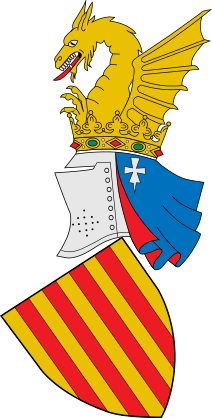 Coat of arms | |
| Anthem: Himne de València "Anthem of Valencia" | |
.svg.png) Location of the Valencian Community within Spain | |
| Coordinates: 39°30′N 0°45′W | |
| Country | Spain |
| Capital | Valencia |
| Provinces | Alicante, Castellón, Valencia |
| Government | |
| • Type | Devolved government in a constitutional monarchy |
| • Body | Generalitat Valenciana |
| • President | Ximo Puig (PSPV-PSOE) |
| Area | |
| • Total | 23,255 km2 (8,979 sq mi) |
| Area rank | 8th (4.6% of Spain) |
| Population (2019) | |
| • Total | 5,003,769 |
| • Density | 220/km2 (560/sq mi) |
| • Pop. rank | 4th (10.4% of Spain) |
| [4] | |
| Demonym(s) | Valencian valencià, -ana (va) valenciano, -na (es) |
| Time zone | UTC+1 (CET) |
| • Summer (DST) | UTC+2 (CEST) |
| ISO 3166 code | ES-VC |
| Area code | +34 96 |
| Official languages | Valencian and Spanish |
| Statute of Autonomy | 1 July 1982 10 April 2006 |
| Patron Saint | Vincent Ferrer |
| Parliament | Corts Valencianes |
| Congress | 32 deputies (out of 350) |
| Senate | 17 senators (out of 265) |
| HDI (2017) | 0.879[5] very high · 11th |
| Website | Generalitat Valenciana |
| 1.^ According to the current legislation the official name is in Valencian Comunitat Valenciana. | |
According to Valencia's Statute of Autonomy, the Valencian people are a nationality.[8] Their origins date back to the Aragonese reconquest of the Moorish Taifa of Valencia, which was taken by James I of Aragon in 1238 during the Reconquista. The newly founded Kingdom of Valencia was granted wide self-government under the Crown of Aragon. Valencia experienced its golden age in the 15th century, as it became the Crown's economic capital. Self-government continued after the unification of the Spanish Kingdom, but was eventually suspended in 1707 by Phillip V of Spain as a result of the Spanish War of Succession. Valencian nationalism resurged towards the end of the 19th century, which led to the modern conception of the Valencian Country. Self-government under the Generalitat Valenciana was finally reestablished in 1982 after Spanish transition to democracy.
Many Valencian people speak Valencian, the region's own co-official language, also known as Catalan in other regions.[9] Valencian is a diglossic language that was repressed and prosecuted during Franco's dictatorship (1939–1975) in favour of Spanish.[10][11][12][13] Since it regained official status in 1982 in the Valencian Statute of Autonomy, Valencian has been implemented in public administration and the education system, leading to an exponential increase in knowledge of its formal standard.[14] According to the general survey from 2015, Valencian is understood by almost the entire population living within the Valencian Community and is spoken by a wide majority, but almost half of the population cannot write it.[15]
Etymology
Valencia was founded by the Romans under the name of "Valentia Edetanorum", which translates to 'Valiance (or Courage) of the Land of the Lamb'. With the establishment of the Taifa of Valencia, the name developed to بلنسية (Balansīyah), which eventually became Valencia after the expulsion of the Moors.
Naming controversy
"Valencian Community" is the standard translation of the official name in Valencian recognized by the Statute of Autonomy of 1982 (Comunitat Valenciana).[8] This is the name most used in public administration, tourism, the media and Spanish written language. However, the variant of "Valencian Country" (País Valencià) that emphasizes the nationality status of the Valencian people is still the preferred one by left-wing parties, civil associations, Catalan written language and major academic institutions like the University of Valencia.
"Valencian Community" is a neologism that was specifically adopted after democratic transition in order to solve the conflict between two competing names: "Valencian Country" and "Former Kingdom of Valencia".[lower-alpha 2] On one hand, "Valencian Country" represented the modern conception of nationality that resurged in the 19th century. It became well-established during the Second Spanish Republic and later on with the works of Joan Fuster in the 1960s, implying the existence of the "Catalan Countries" (Països Catalans). This nationalist subtext was opposed by anti-Catalan blaverists, who proposed "Former Kingdom of Valencia" (Antic Regne de València) instead in order to emphasize Valencian independence from Catalonia. Currently, blaverists have accepted the official denomination.
The autonomous community can be homonymously identified with its capital "Valencia".[16] However, this could be disregarding of the provinces of Alicante and Castellón. Other more anecdotal translations have included "Land of Valencia",[17] "Region of Valencia"[18] and "Valencian Region".[19] The term "Region", however, carries negative connotations among many Valencians because it could deny their nationality status.
History
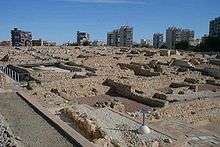
The Pre-Roman autochthonous people of the Valencian Community were the Iberians, who were divided in several groups (the Contestani, the Edetani, the Ilercavones and the Bastetani).
The Greeks established colonies in the coastal towns of Saguntum and Dénia beginning in the 5th century BC, where they traded and mixed with the local Iberian populations. After the end of the First Punic War between Carthage and Rome in 241 BC, which established their limits of influence in the Ebro river, the Carthaginians occupied the whole region. The dispute over the hegemony of Saguntum, a Hellenized Iberian coastal city with diplomatic contacts with Rome, destroyed by Hannibal in 219 BC, ignited the Second Punic War, which ended with the incorporation of the region to the Roman Empire.
The Romans founded the city of Valentia in 138 BC, which, over the centuries overtook Saguntum in importance. After the Fall of the Western Roman Empire, during the Barbarian Invasions in the 5th century AD, the region was first invaded by the Alans and finally ruled by the Visigoths, until the arrival of the Arabs in 711, which left a broad impact in the region, still visible in today's Valencian landscape and culture. After the fall of the Caliphate of Cordoba, two main independent taifas were established at the region, Balansiya and Dénia, along with the small and short living taifas of Orihuela, Alpuente, Jérica and Sagunt and the short Christian conquest of Valencia by El Cid.
However, the origins of present-day Valencia date back to the Kingdom of Valencia, which came into existence in the 13th century. James I of Aragon led the Christian conquest and colonization of the existing Islamic taifas with Aragonese and Catalan colonizers in 1208; they founded the Kingdom of Valencia as a third independent country within the Crown of Aragon in 1238.
The kingdom developed intensively in the 14th and 15th centuries, which are considered the Golden Age of the Valencian Culture,[20] with significant works like the chivalric romance of Tirant lo Blanch. Valencia developed into an important kingdom in Europe economically through the silk trade. It also rose to power politically with the rise of the Crown of Aragon, (within which the Kingdom of Valencia had achieved the largest population and the greatest economic power at that time[21]) and the ascension of the Valencian House of Borja in Rome.
After a slow decline following the dynastic union of the Crown of Aragon with the Kingdom of Castile, Valencia's successful status came to a definite end with the Expulsion of the Moriscos in 1609 by the Hispanic Monarchy, which represented the loss of up to one third of the population of the Kingdom of Valencia and took the main agricultural labor force away.
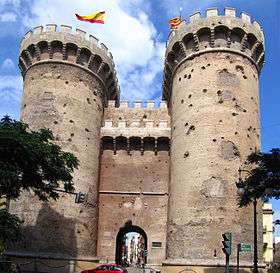
In 1707, in the context of the War of the Spanish Succession, and by means of the Nova Planta decrees, king Philip V of Spain abolished the Kingdom of Valencia, and the rest of states belonging to the former Crown of Aragon and which had retained some autonomy, and subordinated it to the structure of the Kingdom of Castile and its laws and customs. As a result of this, the institutions and laws created by the Furs of Valencia (Furs de València) were abolished and the usage of the Valencian language in official instances and education was forbidden. Consequently, with the House of Bourbon, a new Kingdom of Spain was formed implementing a more centralized government and absolutist regime than the former Habsburg Spain.
The first attempt to gain self-government, or autonomous government, for the Valencian Country in modern-day Spain was during the Second Spanish Republic, in 1936, but the Civil War broke out and the autonomist project was suspended.[22] In 1977, after Franco's dictatorship Valencia started to be partially autonomous with the creation of the Council of the Valencian Country (Consell del País Valencià),[23] and in 1982 the self-government was finally extended into a Statute of Autonomy (Estatut d'Autonomia) creating several self-government institutions under the Generalitat Valenciana. The first democratically elected President of the Generalitat Valenciana, Joan Lerma, took office in 1982 as part of the transition to autonomy.[24]
The Valencian Statute of Autonomy make clear that Valencia is intended to be the modern conception of self-government of the Valencian Country from the first autonomist movements during Second Spanish Republic, but also joining it to the traditional conception of Valencian identity, as being the successor to the historical Kingdom of Valencia.[lower-alpha 2] In fact, after a bipartisan reform of the Valencian Statute of Autonomy in 2006, it records the foral civil law, using the traditional conception of a kingdom, and, on the other hand, it also recognizes Valencia as a nationality, in accordance with the modern conception.
Geography
Relief
The inland part of the territory is craggy, with some of the highest peaks in the Valencia and Castellón provinces forming part of the Iberian mountain range. The mountains in the Province of Alicante are in turn a part of the Subbaetic range.
The most emblematic mountain of the Valencian Community is the Penyagolosa, in the Alcalatén area. It is widely thought to be the highest peak with 1,813 m, but actually the highest peak is the Calderón (1,839 m) located in the Rincón de Ademuz, a Valencian exclave between Aragon and Castilla–La Mancha. The most emblematic mountain in the southern part of the territory is the Aitana (1,558 m).
The rather thin coastal strip is a very fertile plain mainly free of remarkable mountains except those around the Cap de la Nau area in northern Alicante province and the Peñíscola (Peníscola) area in the Castellón province. Typical of this coastal area are wetlands and marshlands such as L'Albufera close to Valencia, El Fondo in Elche (Elx) and Crevillent, La Marjal near Pego, Albufera of Gayanes in Gayanes or El Prat in Cabanes, also the former wetlands and salt evaporation ponds in the Santa Pola and Torrevieja area. All of them are key RAMSAR sites which make Valencia of high relevance for both migratory and resident seabirds and waterbirds.
There are many important coastal dunes in the Saler area near the Albufera and in the Guardamar area, both of them were planted with thousands of trees during the 19th century in order to fix the dunes, thus forming now protected areas of remarkable ecologic value.
In addition to mainland Valencia, the Valencian territory administers the tiny Columbretes Islands and the coastal inhabited islet of Tabarca.
Climate
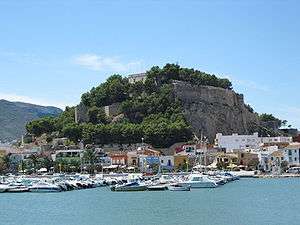
Valencia has a generally mild climate, heavily influenced by the neighbouring Mediterranean sea. Still, there are important differences between areas:
- Proper Mediterranean climate (Köppen Csa). It roughly goes along the coastal plain from the northernmost border through the Benidorm area (cities included here are, amongst others, Castellón de la Plana, Gandia and Valencia). It covers in various grades the lower inland areas. In this area, winters are cool, summers are long, dry and hot; rainfall occurs mostly during spring and autumn, usually totalling around 600 mm. with a remarkably wetter micro climate in the Marina Alta and the Safor comarques just north of Cap de la Nau cape, which accumulates an average of up to 1000 mm. due to an orographic lift phenomenon.
- Mediterranean to continental Mediterranean climate (Köppen Csa) and highland climate (Köppen H). These are the innermost lands and those at a higher elevation (cities included here are, amongst others, Alcoy, Morella, Requena and Villena). Here winters are cool to cold, especially at night (a few days of snow are not unusual), summers mild to hot and rainfall more evenly distributed through the year. The lower registered temperatures in the Valencian Community were in these inland areas during the cold wave of 1956. Temperatures plunged to nearly −20 °C; as in Vistabella del Maestrat (−19 °C) and Castellfort (–17 °C).[25]
- Hot semi-arid climate (Köppen BSh), although in zones at the interior the average temperatures are slightly lower, being BSh in the Köppen climate classification. It roughly goes along the coastal plain from Villajoyosa through the southernmost border of the territory (cities included here are, amongst others, Alicante, Benidorm, Elche, Orihuela and Torrevieja). Summers are hot and dry, winters are mild and its most prominent feature is a very scarce precipitation, typically below 300 mm. per year which is most likely to happen during spring and autumn. The reason for this lack of precipitation is the marked rain shadow effect caused by hills to the west of the Alicante province (and, to a lesser degree, those in the northern part of the province which, in turn, enhance the inverse orographic lift effect around Cap de la Nau).
Hydrography
There are only two major rivers: the Segura in the Province of Alicante, whose source is in Andalusia, and the Júcar (Xúquer) in Province of Valencia, whose source is in Castilla–La Mancha. Both are subjected to very intense human regulation for cities, industries and, especially, agricultural consumption. The river Turia (Túria) is the third largest and has its source in Aragon. Most rivers in the area, such as the Vinalopó, are usually short, have little current (due to agricultural usage, climatic reasons or both) and are often completely dry during the summer. Other Valencian rivers are the Serpis and Sénia.
Demographics
| Year | Pop. | ±% |
|---|---|---|
| 1900 | 1,587,533 | — |
| 1910 | 1,704,127 | +7.3% |
| 1920 | 1,745,514 | +2.4% |
| 1930 | 1,896,738 | +8.7% |
| 1940 | 2,176,670 | +14.8% |
| 1950 | 2,307,068 | +6.0% |
| 1960 | 2,480,879 | +7.5% |
| 1970 | 3,073,255 | +23.9% |
| 1981 | 3,646,870 | +18.7% |
| 1991 | 3,857,234 | +5.8% |
| 2001 | 4,162,776 | +7.9% |
| 2011 | 5,009,931 | +20.4% |
| 2019 | 5,003,769 | −0.1% |
| Source: INE | ||
Urbanization
The estimate population according to the INE on January 2019 is 5,003,769[7] ranking the fourth most populous in Spain. The list of largest cities is topped by Valencia, the third largest city in Spain overall:
Valencian population traditionally concentrated in localities with fertile cultivation and growing lowlands by the most important rivers (Júcar, Turia, Segura, Vinalopó), also in harbour cities important to the agricultural trade. In actuality, population is particularly dense along the coast as well as in central and southern regions of the territory, and more sparse around the inner and northern regions.
.png)
Important historical cities include Sagunt and Dénia in Roman times; Valencia, Alicante, Xàtiva, Orihuela, Elche, Gandia, and Villarreal (Vila-real) later on in history and, more recently, Alzira and Castellón de la Plana. Another set of noncoastal cities increased significantly in numbers due to industrialization in the 20th century, including Alcoy, Elda, Ontinyent, Petrer, Villena, and La Vall d'Uixó. Furthermore, traditionally small fishing towns like Benidorm and Torrevieja have increased in population significantly, more remarkably during summertime, due to seasonal migration of tourists.
Metropolitan areas
In more recent years, concentration in provincial capitals and its metropolitan areas has augmented considerably (e.g. Torrent, Mislata, Paterna, Burjassot, San Vicent del Raspeig, etc.). Besides Valencia, Alicante-Elche is the eighth most populous urban agglomeration in Spain. According to the INE, the largest metropolitan areas are:
| Rank | Metropolitan Area | Province | Population |
|---|---|---|---|
| 1 | Valencia | Valencia | 1,705,742 |
| 2 | Alicante–Elche | Alicante | 785,020 |
| 3 | Castellón de la Plana | Castellón | 386,906 |
| 4 | Alzira–Xàtiva | Valencia | 348,582 |
| 5 | Benidorm–Villajoyosa | Alicante | 183,253 |
Government
Institutions of government: La Generalitat
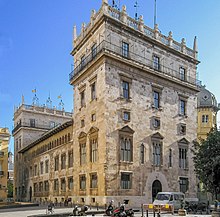
In the process whereby democracy was restored in Spain between 1975 and 1978, the nationalist and regionalist parties pressed to grant home rule to certain territories in Spain. The constitution of 1978 opened a legal way for autonomous communities to be formed from provinces with common historical and cultural links. In recognition of the Valencian Country as a nationality of Spain, and in accordance to the second article of the Spanish Constitution which grants autonomy to the "nationalities and regions" that compose the Spanish nation, Valencia was granted self-government and constituted itself as an autonomous community in 1982, with the promulgation of its first Statute of Autonomy, the basic organic law, later approved by the General Courts of Spain.
All autonomous communities were organized politically within a parliamentary system; that is, the executive branch of government. The "President" is dependent on the direct support of the legislative power, whose members elect him by majority.
A new Statute of Autonomy was promulgated in 2006. The government of Valencia is represented by the Generalitat Valenciana (statutorily referred to simply as La Generalitat) constituted by three institutions:[26]
- the Corts Valencianes (Valencian parliament), the legislature, which is to be integrated by a minimum of ninety-two representatives (diputats) elected through universal suffrage by proportional representation for a four-year period;
- the President of the Generalitat Valenciana elected by the Courts from which s/he must obtain the vote of confidence; the current President is Ximo Puig (from the Socialist Party of the Valencian Country). The Vice President is Mònica Oltra (from Compromís, a Valencianist party).
- the Council of the Generalitat Valenciana (Valencian government), a collegiate institution with executive powers, integrated by the President him/herself and the cabinet members appointed by him/her.
The Generalitat can also be integrated by the institutions that the Valencian Courts create. The Courts have approved the creation of the Síndic de Greuges (Ombudsman), the Sindicatura de Comptes (Public Audit Office), the Consell Valencià de Cultura (Valencian Council of Culture), the Acadèmia Valenciana de la Llengua (Valencian Academy of the Language), the Consell Jurídic Consultiu (Juridic and Consultative Council) and the Comité Econòmic i Social (Social and Economic Committee).
The current government is formed by a left coalition between the Socialist Party of the Valencian Country and Compromís, with also the support of Podemos.
Economy
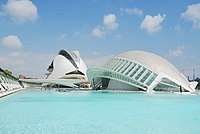
Valencia is long and narrow, running mainly north-south; historically, its rather steep and irregular terrain has made communications and the exploitation of the soil difficult, although the soil of the coastal plain is particularly fertile. This coastal axis has facilitated connections with Europe, either by sea through the Mediterranean, or by land through Catalonia.
The Valencian territory has few natural resources; the only important mineral deposit is the marble quarried in Alicante province.
Hydrological resources (see Geography above) are also lacking: the demand for water exceeds the supply, with this imbalance especially serious in Alicante province. In particularly severe drought years, the problem is managed through occasional nocturnal restrictions during summer and exploitation of aquifers. Valencia's water needs result in harsh contention with neighbouring regions such as Castilla–La Mancha and Catalonia.
Agriculture—more specifically, citrus cultivation for the export market—was responsible for Valencia's first economic boom in the late 19th century, after centuries of slow development and even decay. Although in absolute terms the agricultural sector has continued to grow, the boom in the secondary and tertiary sectors during the Spanish miracle of the 1960s, has meant that its relative importance has decreased over time. The provinces of Castelló and Valencia still have thousands of hectares of citrus-producing groves and citrus continues to be a major source of income on the countryside. Province of Alicante also grows citrus, but its agriculture is more diversified with a higher presence of vegetables, especially in the Vega Baja del Segura area.
Though the low insulation rate and overall stable weather during the summer may pose a threat to water supplies for agriculture and human consumption, conversely this climate allows tourism to be the province's main industry. Very dense residential housing along the coast, occupied by locals, people from inland Spain and from other EU countries (mostly from the British Isles, Benelux, Germany and Scandinavia), boosts the summertime population (and hydrological demands).
In 2004, Valencia's GDP was 93.9% of the European Union average,[27] although this figure may be too low because of the important presence of foreign residents either from other regions of Europe or as economic immigrants, who are not properly represented in the official statistics. As in all of Spain, there was significant growth in the years immediately following 2004, at least until the 2008–13 Spanish financial crisis.
In 2008, the Valencia Country generated 9.7% of the Spanish GDP. In L of human resources, the unemployment rate was over 21% in 2009, and even greater among women,[28] and the rate of activity reached 56.8% in 2002. The typical Valencian business is a small-to-medium-sized company, mainly family-owned and operated, although there are some multinationals.
In addition to tourism, the Valencian Country has significant exports, and it ranks second in this respect among the Spanish autonomous communities, constituting 12% of the national total. Major exports include agricultural products, ceramic tiles, marble products and cars (Ford has an assembly line in Almussafes), which make the port of Valencia one the busiest in Europe.
Unemployment
The unemployment rate stood at 15.6% in 2018 and was higher than the national average.[29]
| Year | 2006 | 2007 | 2008 | 2009 | 2010 | 2011 | 2012 | 2013 | 2014 | 2015 | 2016 | 2017 | 2018 |
|---|---|---|---|---|---|---|---|---|---|---|---|---|---|
| unemployment rate (in %) |
8.3 | 8.7 | 12.0 | 20.8 | 22.9 | 24.0 | 27.2 | 28.0 | 25.8 | 22.8 | 20.6 | 18.2 | 15.6 |
Language
Spanish (Castilian or castellano) has official status in all of Spain, including the Valencian Community. Aside from it, the Statute of Autonomy recognizes Valencian as the language proper to the Valencian people (llengua pròpia), and commends its protection and regulation to the Acadèmia Valenciana de la Llengua (AVL) under the Generalitat Valenciana.
Valencian is the name Valencians use to refer to the Catalan language.[30] In the Late Middle Ages, due to Valencia becoming its own kingdom, Valencians popularized the term Valencian over the term Catalan.[31]
Valencian Sign Language is widely used by Valencian deaf persons and is also granted protection under the Statute.
Areas of linguistic predominance
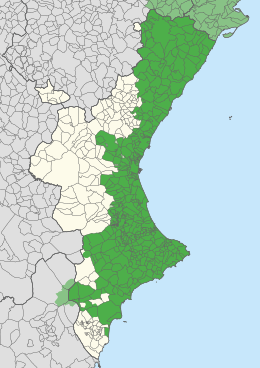
Not all of the Valencian territory is historically Valencian-speaking, with 10% of the population, 500,000, living in traditionally Spanish-speaking inner regions. Also large numbers of foreign immigrants since 2000 become Spanish speakers. These regions include the areas where Aragonese rather than Catalan settlers introduced Castilian-Aragonese language in the historic Kingdom of Valencia, as well as several Castilian municipalities that were annexed to the Valencian Community in the 19th century. Valencian is traditionally spoken in the more densely populated coastal areas where Catalan settlers introduced their language in the Middle Ages. These areas are delimited for administrative purposes by the Generalitat, that established different areas of linguistic predominance (predomini lingüístic). The Valencian area of linguistic predominance suffers in many cases a process of linguistic substitution, especially in the cities of Valencia and Alicante, with populations of 1 million together where Spanish has become predominant in spite of Valencian being the traditional language. Outside these areas and the traditional Spanish-speaking areas in the west Valencian predominates or is on an equal footing.
Knowledge
| Knowledge of Valencian | ||||
|---|---|---|---|---|
| 1986 | 1991 | 2001 | 2011 | |
| Can understand | 77.12% | 83.24% | 86.36% | 84.78% |
| Can speak | 49.49% | 51.09% | 48.88% | 51.18% |
| Can read | 24.36% | 37.98% | 47.24% | 58.35% |
| Can write | 7.03% | 15.17% | 24.07% | 31.77% |
| Source: Conselleria d'Educació, Cultura i Esport (2010) Cens 2011. Dades generals coneixement[32] | ||||
Most of the population have at least a passive knowledge of Valencian, which allows normal communication in this language across the Valencian Community. Thanks to its implementation in public administration and the education system in recent decades, knowledge of Valencian has increased phenomenally both in absolute and relative terms, most significantly in the case of its written standard. The source also reveals that knowledge varies greatly within the territory, with knowledge in the Province of Alicante being consistently lower than in Castellón and Valencia.
Social use
| Languages spoken at home | ||
|---|---|---|
| Use | Valencian | Spanish |
| Always | 28.8% | 56.2% |
| More often | 3% | 2.6% |
| Alternatively | 5.6% | |
| Other languages | 3.8% | |
| Source: Conselleria d'Educació, Cultura i Esport (2010) Knowledge and social use of Valencian[33] | ||
Despite the increase in knowledge of Valencian, its social use in relative terms is declining, with only a third of the population using it at home according to the Generalitat in 2010. The data collected varies greatly within the Valencian Community, with the percentage of use being over 50% in the regions of Alcoy-Gandia and Júcar-Turia, approximately 40% in Castelló and about 15% in Alicante and the Valencia metropolitan area.
Valencian language controversy
Despite differences in dialect and denomination, linguists consider Catalan and Valencian two varieties of the same language. They feature relative uniformity in terms of vocabulary, semantics, syntax, morphology and phonology. Mutual intelligibility ranges from 90 to 95%, which is considerably higher than between dialects of an assumed single German language (High German). Furthermore, there is a dialect continuum where speakers at the Catalan–Valencian border share the same dialect. In practice, Catalan and Valencian share the same written standard, as established by the Institut d'Estudis Catalans and the AVL respectively. Much of the bibliography used in the Valencian education system consists of Catalan works and translations in Catalan with only occasionally some words being swapped for those more commonly used in Valencia. Furthermore, the Universities of Valencia and Alicante refer to Valencian studies of language and literature as Catalan Philology.
In spite of these arguments, a significant proportion of Valencian population refuse to identify Valencian with Catalan.
Transports
Air
The Valencian Community is served by three international airports: Alicante Airport, Valencia Airport and Castellón–Costa Azahar Airport. Alicante Airport, located in the south, is mainly tourist-oriented and is currently the busiest airport in the Valencian Community. Valencia Airport is located in the capital and carries more business traffic. The third airport, Castellón–Costa Azahar Airport, is located in the north of the Valencian territory and has several international connections. This airport was opened in 2011 but its first commercial flight arrived on September 2015, so it has been considered as a white elephant due to its expensive construction and maintenance and relatively less usefulness.[34]
A new terminal at Alicante Airport was opened in March 2011. The New Alicante Terminal (NAT) replaced the other two existing terminals T1 and T2, doubling the passenger capacity of the airport to 20m passengers per annum. Valencia airport is also being expanded to serve the higher passenger demand due to new flight connections to the city.
Train
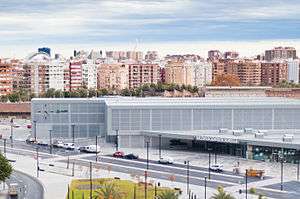
The Valencian Community has an extensive rail system which connects the principal cities with the rest of Spain such as the Euromed towards Catalonia and AVE towards Madrid, or northern and southern Spain, both run by the Spanish national rail company RENFE.
In December 2010 the high-speed rail (AVE) Madrid–Valencia opened as part of the Madrid–Levante high-speed rail line. The current high-speed station, Valencia-Joaquín Sorolla, is a provisional station located in the outskirts of the city of Valencia. It is expected that in the coming years the high-speed line Madrid–Valencia will reach Valencia Central Station through a tunnel under the new (Valencia Central Park).
High-speed rail Madrid–Alicante is planned to open in 2012 with a provisional station in the outskirts.
There are some medium-range plans for further high-speed connections, like the Valencia–Bilbao link via Zaragoza or the Mediterranean high-speed rail corridor.
In addition, the Generalitat Valenciana has planned on building a regional high-speed rail along the coast to connect all major coastal cities like Valencia, Gandia, Dénia, Benidorm, Villajoyosa, Alicante and Torrevieja.
Commuter rail and Metro
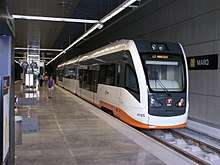
Cercanías (Rodalia in Valencian) is the commuter rail service that serves all three provincial capitals of Valencia and their metropolitan areas. It is operated by Cercanías Renfe, the commuter rail division of RENFE.
While the Valencian-owned company, Ferrocarrils de la Generalitat Valenciana (FGV) operates a tram-train line between Alicante, Benidorm and Dénia. It also operates the city tram and metro system of Valencia (Valencia Metro) and Alicante (Alicante Tram). There is as well a third new tram and trolleybus system being built in Castellón de la Plana and its metropolitan area. Additionally both, Valencia metro and Alicante tram are being extended to serve uncovered areas, like the new tram line planned to open in the coming months towards the University of Alicante and San Vicente del Raspeig.
Seaports
Public services
Education
State Education in Spain and the Valencian Community is free and compulsory from six to sixteen years of age. The current education system is called LOE (in reference to the Llei Orgànica d'Educació).[35]
- From three to six years: Preparatory School (Infantil, popularly known as Preescolar)
- From six to twelve years: Primary School (Primaria)
- From twelve to sixteen years: Compulsory Secondary School (Secundaria)
- From sixteen to eighteen years: Post-Secondary School (Bachillerato)
Children from three to five years old in the Valencian Community have the option of attending the infantil or Pre-school stage, which is non-compulsory and free for all students. It is regarded as an integral part of the education system with infantil classes in almost every primary school. There are some separate nursery schools.
Valencian students aged six to sixteen undergo primary and secondary school education, which are compulsory and free of charge. Successful students are awarded a Secondary Education Certificate, which is necessary for entering further (optional) education as for their University or Vocational Studies. Once students have finished their Batxillerat (Spanish: Bachillerato), they can take the PAU exams (Proves d'Accés a la Universitat), commonly known as Selectiu.
The secondary stage of education is normally referred to by their initials, e.g. ESO standing for Educació Secundària Obligatòria.
The Valencian Community is home to a number of prestigious universities like the University of Valencia, founded in 1499. At the request of James I of Aragon, Pope Innocent IV in 1246, authorized by a papal bull the establishment of estudis generals in Valencia. The University Statutes were passed by the municipal magistrates of Valencia on April 30, 1499; this is considered to be the 'founding' of the University. In 1501, Pope Alexander VI signed the bill of approval and one year later Ferdinand II of Aragon proclaimed the Royal Mandatory Concession. Only very meagre accounts have been preserved of the practical workings of the university. From the time of its foundation the courses included Latin, Greek, Hebrew, Arabic, philosophy, mathematics, physics, theology, Canon law, and medicine.
Nowadays the Polytechnic University of Valencia has become one of the most prestigious universities in Spain, according to its technology, investigation, several degrees offering a close relation with some the most important universities in the world such as Cambridge, Oxford and Harvard. Most faculties and colleges are based in the city of Valencia, with some branches in Gandia and Alcoy.
Other universities are University of Alicante, Miguel Hernández University in Elche, Jaume I University and Valencian International University in Castellón de la Plana, Catholic University of Valencia, and CEU Cardenal Herrera University in Valencia.
Media
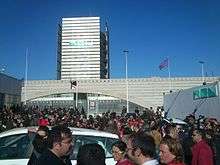
Until its dissolution on November 2013, the public-service Ràdio Televisió Valenciana (RTVV) was the main broadcaster of radio and television in the Valencian Community. The Generalitat Valenciana constituted it in 1984 in order to guarantee the freedom of information of the Valencian people in their own language.[36]
Prior to its dissolution, the administration of RTVV under the People's Party (PP) had been controversial due to accusations of ideological manipulation and lack of plurality. The news broadcast was accused of giving marginal coverage of the Valencia Metro derailment in 2006 and the indictment of President de la Generalitat Francisco Camps in the Gürtel scandal in 2009.[37] Supervisors appointed by the PP were accused of sexual harassment.[38]
In face of an increasing debt and shrinking audiences that had fallen under 10 and even 5% of share in recent years, RTVV announced in 2012 a plan to shed 70% of its labour. The plan was nullified on 5 November 2013 by the National Court after trade unions appealed against it. On that same day, the President de la Generalitat Alberto Fabra announced RTVV would be closed, claiming that reinstating the employees was untenable.[39] On 27 November, the legislative assembly passed the dissolution of RTVV and employees organized to take control of the broadcast, starting a campaign against the PP. Nou TV's last broadcast ended abruptly when Spanish police pulled the plug at 12:19 on 29 November 2013.[40]
Having lost all revenues from advertisements and facing high costs from the termination of hundreds of contracts, critics question whether the closure of RTVV has improved the financial situation of the Generalitat, and point out to plans to benefit private-owned media.[41] Currently, the availability of media in the Valencian language is extremely limited. All the other autonomous communities in Spain, including the monolingual ones, have public-service broadcasters, with the Valencian Community being the only exception despite being the fourth most populated.
In 2016 the renewed Valencian government announced that a new public media corporation was to be created. The Valencian Media Corporation was founded on July 2016, as it started the creation of a new TV channel and radio station, by the name of À Punt. On June 2018 the new public TV channel was launched by Valencian Media Corporation, the newly formed agency of the Generalitat Valenciana.
Culture
Gastronomy

The Valencian gastronomy is of great variety, although their more international dishes are rice-based (arròs in Valencian), like the Valencian paella known worldwide. Rice is a basic ingredient in many of the typical dishes, like the arròs negre, arròs amb costra, arròs a banda, arròs a la pedra, arròs caldós, among many.
The Valencian Mediterranean climate favors the cultivation of vegetables and citrus fruits, with the cultivation of the orange being perhaps of highest importance as one of the typical fruits of Valencian agriculture.
Horchata (orxata in Valencian), production of which has traditionally been centred around Alboraya (Alboraia), is a typical drink, accompanied with fartons. Also traditional are the production of coffee liqueur (typical of Alcoy), and mistela (in Marina Baixa and Hoya de Buñol (Foia de Bunyol)). Another one is Agua de Valencia, in Valencian Aigua de València, it is a cocktail made from a base of cava or champagne, orange juice, vodka, and gin. In general, it is served in pitchers of various sizes and is drunk in a broad cocktail glass. It was made for the first time in 1959 by Constante Gil in the bar Café Madrid, in the city of Valencia.
The great majority of desserts typical of Valencia have their origin in Arabic times and play an important part in the local festive activities. Some are internationally famous. Xixona is the place of traditional manufacture of turrón, torró in Valencian (a soft nougat), consumed during Christmas in Spain and the rest of the Hispanic world. In Casinos the turrón is typical too but the most important manufacture of the village is peladillas (dragées and sugared almonds). In Xàtiva, the arnadí, a dessert elaborated with pumpkin is made. Orihuela and its region have the almojábanas.
Valencian symbols

The official Valencian anthem is the Hymn of the Regional Exhibition of 1909 (Himne de l'Exposició Regional de 1909 in Valencian; commonly known as the Himne de València, "Anthem of Valencia"), in whose composition the old hymn of the City of Valencia of the 16th century is included. The emblem of the Valencian Generalitat (coat of arms) includes the heraldry of King Peter IV of Aragon, representative of the historical Kingdom of Valencia, whose shield is inclined towards the right, or, four bars Gules.
The official flag, the Royal Senyera (Reial Senyera), also known as Senyera Coronada (Crowned Senyera) or Senyera Tricolor (Tricolour Senyera) is the same as Valencia's City flag, which, in turn, is a historical derivation of the Senyera, the heraldic symbol of the Crown of Aragon, also used today with few variations in all the former Kingdoms and Counties which were a part of this crown. There are also a number of Valencian private and civil entities such as trade unions,[42] cultural associations,[43] or political parties[44] which simply use the Senyera as Valencian flag.
Other symbols are used at different levels by the Valencian society, like the heraldic animals of rat-penat (a bat) and drac alat (a winged dragon which was the emblem of James I).
One of the most recognised and representative valencian symbols are the music and dance of the Muixeranga, ancient tradition of human towers preserved for the last 4 centuries, during the Festivity of 'La Mare de Déu de la Salut Festival' of Algemesí, recognized-UNESCO "intangible heritage of humanity". Typical folk music in celebrations is played with the tabalet (a drum) and the dolçaina (a flute). Valencian traditional costumes and dresses include espardenyes (shoes) and traditional fallera dresses (the Falles dresses).
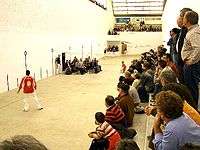
Celebrations
- Moors and Christians of Alcoy
- Falles
- Bonfires of Saint John
- Mystery Play of Elche
- Muixeranga
- Moros y cristianos
- Tomatina
- Festes de la Magdalena
Sports
The autochthonous Valencian sport is the Valencian pilota, which features a professional Valencian Pilota Squad for international matches with related ball games all around the world. This sport has many variants, that may be played at the streets or at special courtfields like the trinquet. It may also be played by teams or on individual challenges. An amazing trait of this sport is that spectators may sit very close or even in the middle of the court. Even while the match is ongoing bookmakers take bets for reds or blues, since these are the colours players must wear, red being the colour of the strongest team or player. The Valencian pilota can be traced to the 15th century, but it was abandoned during modern times, this decadence is being fought back with TV broadcasts, new built colleges have courtfields and a new professional players firm, ValNet
Association football is the most widely known and played sport. There are teams in every town or village, three of which are currently playing in La Liga, Spain's premier league: Valencia CF, Villarreal CF and Levante UD. There are many big teams elsewhere, such Elche CF (currently playing in Spain's second league), CD Alcoyano, Hércules CF, and CD Castellón.
Professional basketball is represented by one team, Valencia Basket in the top league, the Liga ACB. Also, Ros Casares Valencia is a female basketball team, which has been champion of the Spanish Women's League and finalist of the EuroLeague Women. Regarding female professional sports, Valencian handball rules the Spanish Honor division league with more than half of the teams, such as CE Handbol Marítim (Astroc Sagunto) and CBF Elda (Elda Prestigio).
Motorcycle races are very popular, as the Circuit of Valencia race track and its hosted Valencian Community Grand Prix prove. Many Valencian MotoGP pilots such as Héctor Barberá, Héctor Faubel or Nicolás Terol have been competing in different MotoGP classes.
Another relevant game is the pigeon sport, with an autochthonous dove race being trained, the gavatxut valencià.
Petanca and its variant Calitx are traditional sports as well, especially in towns or among elders.
Image gallery



.jpg) Rock of Ifac in Calp
Rock of Ifac in Calp- Altamira Palace, Elche
- Elche palm grove


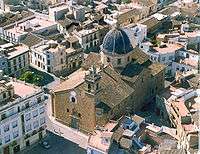

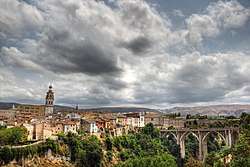

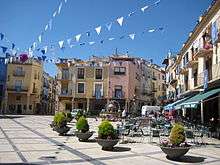
 Sueca
Sueca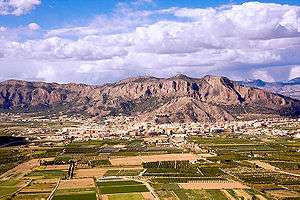 Orihuela, Vega Baja del Segura comarca
Orihuela, Vega Baja del Segura comarca
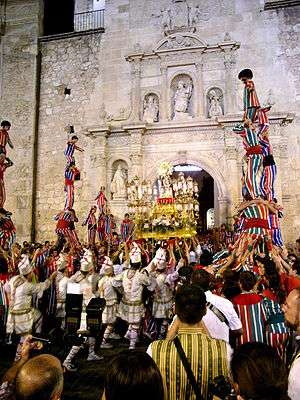
 Valencian espardenya
Valencian espardenya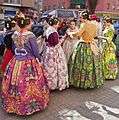 Valencian women with traditional dress and hair
Valencian women with traditional dress and hair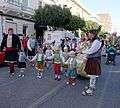 A historical Valencian men costume the Xaraguell
A historical Valencian men costume the Xaraguell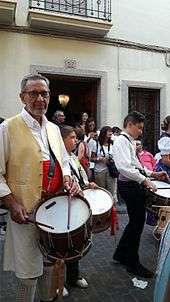 Tabaleter with typical Valencian drums
Tabaleter with typical Valencian drums
See also
Notes
- Pronunciation:
- Preamble on Valencian Statutes of Autonomy 1982 and 2006: "Aprovada la Constitució Espanyola, va ser, en el seu marc, on la tradició valenciana provinent de l'històric Regne de València es va trobar amb la concepció moderna del País Valencià i va donar origen a l'autonomia valenciana [...]"[6]
References
- See Valencia in: Jones, Daniel (2003) [1917], Peter Roach; James Hartmann; Jane Setter (eds.), English Pronouncing Dictionary, Cambridge: Cambridge University Press, ISBN 3-12-539683-2
- See Valencia in: Jones, Daniel (2003) [1917], Peter Roach; James Hartmann; Jane Setter (eds.), English Pronouncing Dictionary, Cambridge: Cambridge University Press, ISBN 3-12-539683-2
- See Valencia in: Jones, Daniel (2003) [1917], Peter Roach; James Hartmann; Jane Setter (eds.), English Pronouncing Dictionary, Cambridge: Cambridge University Press, ISBN 3-12-539683-2
- Instituto Nacional de Estadística, Madrid, 2019.
- "Sub-national HDI - Area Database - Global Data Lab". hdi.globaldatalab.org. Retrieved 2018-09-13.
- Preamble of Valencian Statute of Autonomy (reformed in 2006)
- "El País Valencià perd habitants per primera vegada des de 1996". La Veu del País Valencià. March 2013. Retrieved 9 April 2015.
- "Estatut d'Autonomia". Corts Valencianes. 1982. Archived from the original on 3 October 2018. Retrieved 9 April 2015.
- According to article Catalan language from Britannica Online Encyclopedia
- The implementation of Franco's regime in the Valencian Community since 1939 meant the Valencian ban on its use on the radio, books, theater, different civilians forms such as wedding invitations, signs and announcements, person's first names, cinema (until 1964), in all public and private schools, on the gravestones of the cemeteries and mortuary skeletons, in the nomenclature of hotels, restaurants or brands, on inscriptions in the Civil register, on the names of the streets, among other fields. Mayans Balcells, Pere (2019). Cròniques negres del català a l'escola. Edicions de 1979. ISBN 9788494720147.
- Solé i Sabaté, Josep M.; Villaroya, Joan (1994). Cronologia de la repressió de la llengua i la cultura catalanes 1936-1975. Barcelona: Curial. ISBN 8472569578.
- Ferrer i Gironés, Francesc (1985). La persecució política de la llengua catalana. Barcelona: Edicions 62. ISBN 8429723633.CS1 maint: ref=harv (link)
- Ministerio de la Gobernación (Gazeta of 17 May 1940) (CCITT T.& G4 Facsimile TIFF). Order of 16 May 1940 forbidding the use of generic foreign terms in lettering, samples, advertisements, etc.
- "La població que sap escriure en català es quintuplica en els últims 25 anys". Conselleria d'Educació, Cultura i Esport. November 2014. Archived from the original on 23 September 2015. Retrieved 9 April 2015.
- "Knowledge and social use of Valencian language. General survey 2015. Synthesis of results". Conselleria d'Educació i Cultura, Generalitat Valenciana. Valencian government (Generalitat Valenciana). 2015. Retrieved 3 April 2020.
- According to article Valencia from Britannica Online Encyclopedia
- Scenery in Land of Valencia Archived 2008-05-09 at the Wayback Machine, edited by the Valencian Agency of Tourism
- Terms mainly used from the Department of Tourism of the Valencian Government. See official publications, and an example Archived 2008-05-12 at the Wayback Machine of using "Region of Valencia". The other term, "Land of Valencia" is also used by this department
- CVNews, English-language magazine published by the Valencia Region Tourist Board
- es:Siglo de Oro Valenciano
- José Escribano Úbeda-Portugués: España y Europa a través de la Historia. Desde el siglo XV al Siglo XVIII pp 16-17
- es:Proyecto de Estatuto de Autonomía para el País Valenciano (1937)
- es:Real Decreto-Ley 10/1978, de 17 de marzo, por el que se aprueba el Régimen Preautonómico del País Valenciano
- Caballer, Neus (2011-10-07). "Fallece el expresidente preautonómico de la Generalitat Enrique Monsonís" [Former pre-autonomous president of the Generalitat Enrique Monsonís dies]. El País (in Spanish).
- José Ángel Núñez; Carlos Muedra; Vicente Aupí. "La gran ola de frío de febrero de 1956 en la España mediterránea" [The great cold snap of February 1956 in Mediterranean Spain] (PDF) (in Spanish).
- "Third Section, First Chapter of the Statute of Autonomy of the Valencian Community" (in Spanish). Archived from the original on 2007-12-26. Retrieved 2007-12-14.
- "Regional GDP per inhabitant in the EU27: GDP per inhabitant in 2004 ranged from 24% of the EU27 average in Nord-Est in Romania to 303% in Inner London" (PDF), Eurostat News Release, Eurostat Press Office, 19 February 2007, archived from the original (PDF) on 2009-03-26, retrieved 2012-11-17
- "El paro alcanza el 23% en la Comunidad Valenciana" [Unemployment reaches 23% in the Valencian Community]. Valencia Plaza (in Spanish). EFE.
- "Regional Unemployment by NUTS2 Region". Eurostat. European Union.
- "Mobile". Diccionari normatiu valencià. Archived from the original on 30 September 2018. Retrieved 9 March 2011.
- Beltran i Calvo & Segura i Llopes 2018, p. 35.
- "Cens 2011. Dades generals coneixement" [Census 2011. General information]. Conselleria d'Educació, Cultura i Esport (in Valencian). 2011. Archived from the original on 14 April 2015. Retrieved 9 April 2015.
- "Coneixement i ús social del valencià" [Knowledge and Social Use of Valencian]. Conselleria d'Educació, Cultura i Esport. 2010. Archived from the original on 23 September 2015. Retrieved 9 April 2015.
- Ortega, Lorena (15 September 2015). "First commercial flight lands at Castellón's former 'ghost' airport". El País.
- "Sistema Educativo LOE" [LOE Educational System]. Spanish Ministry of Education (in Spanish). Archived from the original on 2007-03-11.
- "Ley de Creación de la Entidad Pública Radiotelevisión Valenciana (RTVV)" [Law on the Creation of the Public Entity Radiotelevisión Valenciana (RTVV)] (PDF) (in Spanish). 1984. Archived from the original (PDF) on 5 December 2013. Retrieved 9 April 2015 – via UGT RTTV.
- "Los escándalos de Canal 9" [The Channel 9 scandals]. VerteleTV (in Spanish). 7 November 2013. Retrieved 9 April 2015.
- "Sanz, destituït de secretari general de RTVV per assetjament sexual" [Sanz, dismissed as RTVV's secretary general for sexual harassment]. Vilaweb (in Catalan). 28 May 2010. Retrieved 9 April 2015.
- Bono, Ferran (7 November 2013). "El fracaso de Fabra acaba con el PP" [Fabra's failure ends with RTVV]. El País (in Spanish). Retrieved 9 April 2015.
- "Police evict TV staff in Spain after closure of station". BBC News. 29 November 2013. Retrieved 9 April 2015.
- "El coste del cierre de RTVV asciende a 144,1 millones". Levante-EMV. 2014. Retrieved 9 April 2015.
- See logo of one of major trade unions: CCOO-PV
- See usage of the Senyera by a Valencian cultural association: ACPV Archived 2007-07-05 at the Wayback Machine
- See usage of Senyera by political parties EUPV, Bloc Nacionalista Valencià, Green Parties, amongst others, whose combined participation in the Autonomous Elections of 2007 achieved 9% of the total votes.
Bibliography
- El llarg camí cap a l'Autonomia Valenciana, de Vicente Ruiz Monrabal. Revista Valenciana d'Estudis autonòmics, núm. 41/42, 3er trimestre de 2003 - 4o trimestre de 2003, p. 372-421. URL: Número 41/42.
- El valencianisme polític, 1874-1936, Alfons Cucó i Giner. 1999, Catarroja, Ed. Afers SL. ISBN 84-86574-73-0.
- Història del País Valencià, Vicente Boix. 1981. Editorial Planeta, ISBN 84-390-0148-7.
- Història del País Valencià, Antoni Furió i Diego. 2001. Edicions 3i4. ISBN 84-7502-631-1.
External links
| Wikimedia Commons has media related to Valencia. |
| Wikivoyage has a travel guide for Valencia. |
